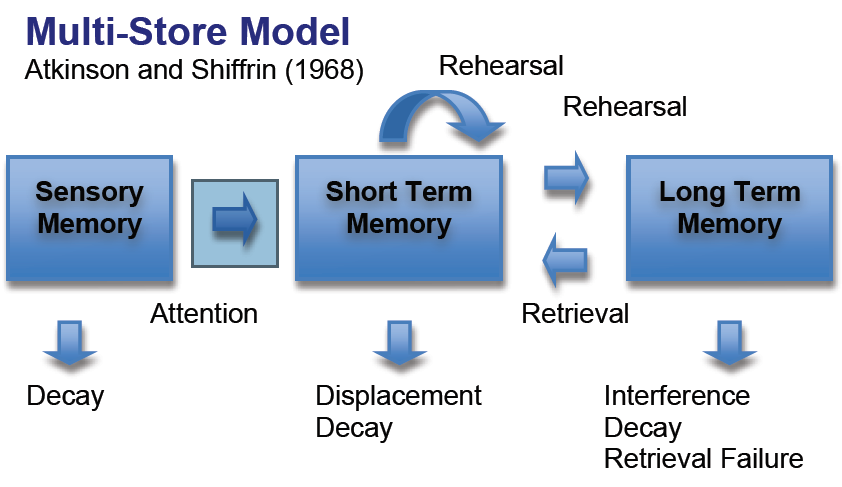2) The Multistore Model of Memory
1/10
There's no tags or description
Looks like no tags are added yet.
Name | Mastery | Learn | Test | Matching | Spaced |
|---|
No study sessions yet.
11 Terms
Who invented the multi store model of memory?
Atkinson and Shiffrin (1968)
Draw the Multistore Model of memory?

Name the two processes by which information is moved through the Multistore Model?
Attention
Rehearsal
Describe how information moves through each store?
Memories are formed sequentially as information passes from one store to the next in a linear fashion.
Describe the Multistore Model of memory?
Information enters the sensory register via our senses.
It has an unknown but supposedly unlimited capacity.
It has a very small duration of 250 milliseconds.
As information enters from all five senses, the coding is modality specific.
It is said to be unprocessed information.
Information is passed to the STM if paid attention to.
It is coded acoustically, limited capacity, 30 second duration.
Maintenance rehearsal is used to keep information in the STM.
Thereafter, information that is rehearsed is transferred to the LTM.
It is coded semantically, unlimited capacity, long duration.
Forgetting can occur at any stage in various ways,
SENSORY MEMORY: Information decays rapidly if not paid attention to.
STM: Information decays or displacement occurs.
LTM: Prone to retrieval failure and interference.
Name the two effects of displacement at the STM?
Primacy Effect
Latency effect
Describe what the primacy effect is, as an effect of displacement?
You hear the first bit of information that you hear.
Describe what the latency effect is, as an effect of displacement?
You remember the last bit of information that you hear.
What word is used to describe both the STM and the LTM in the Multistore Model of memory, and what does this mean?
Unitary- only one store.
Evaluate a discussion point of the multi store model of memory?
DISCUSSION: RESEARCH SUPPORT FOR SEPERATE STORES
Research into STM and LTM has shown that the two stores have fundamental differences in terms of coding, capacity and duration.
Such as acoustic coding in STM and semantic coding in LTM.
However, these studies do also have flaws which lower their validity.
Therefore, the Multistore Model may not be entirely valid due to the nature of evidence used to support it.
Evaluate weaknesses of the multi store model of memory?
WEAKNESS: CLINICAL EVIDENCE TO CHALLENGE UNITARY STORES
The multi store model states that both the STM and LTM are unitary stores.
However, clinical evidence using case studies shows there could be more than one type of STM.
SHALLICE AND WARRINGTON:
Studied patient KF whose STM for digits was poor when read to him.
However, when he was able to read the digits himself, his STM was good.
This suggests that there may be two types of STM store.
One for sounds and one for images.
Therefore, it challenges the Multi store model, as the unitary aspect of the stores is a fundamental feature.
WEAKNESS: AN OUTDATED MODEL
There is evidence for both multiple STM stores and multiple LTM stores.
Atkinson and Shiffrin based the MSM on evidence available at the time, showing the STM and the LTM to be single, independent and separate stores.
However, research shows that the LTM is not a single store.
e.g: one store for memories of facts about the world, and another for procedural memories of how to ride a bike.
There is further research showing more than one type of STM, and even more than one type of rehearsal.
Thus, suggesting that the model is outdated and oversimplified.
WEAKNESS: CASE STUDY RESEARCH
CLIVE WEARING:
Clive Wearing challenges the idea of the LTM as a unitary store.
He can play the piano but could not remember significant life events.
This contradicts the LTM as a unitary store, as he should. not be able play piano if he cannot remember life events.
Therefore, MSM must be hugely oversimplified.